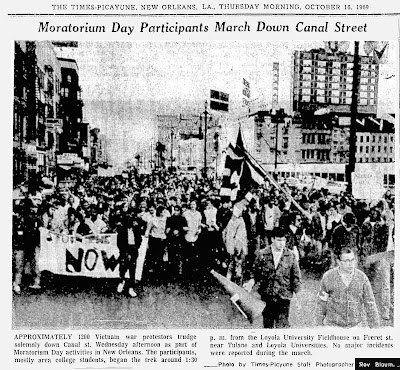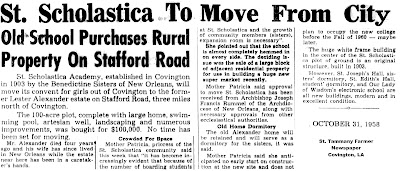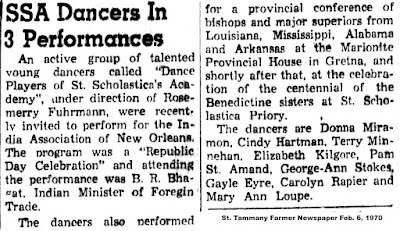The land in the southeast quadrant of the Stafford Road/Smith Road intersection north of Covington was originally homesteaded in the mid-1800's on a land grant given to Joseph Schneyder. The title for the property was recorded in 1890.
The area was the home of St. Benedict's Chapel, one of the first churches in the rural areas northeast of Covington.
Click on the articles to make them larger and more readable.
In the 1930's Schneyder heirs sold some of it to Lester Alexander, who named it "The Flying A Ranch." He was head of the Alexandria Shipyard and a well-known area industrialist. In 1952 he was listed among the many Covington area civic leaders who were taking part in a fund-raising drive for the Benedictine Sisters.
The shipbuildinghistory.com website provided the following information:
AMERICAN MARINE CORP. New Orleans LA
Lester F. Alexander started this shipyard on the east side of the Industrial Canal in New Orleans, immediately south of the I-10 bridge, before World War II. The yard was a pioneer of the offshore industry, building not only the famous "Breton Rig 20" and John LaBorde's early submersibles but also the first supply boats for Tidewater.
He was also instrumental in proposing the Mississippi River Gulf Outlet canal.
Alexander died in 1957.
The property was purchased by the Benedictine Sisters in 1958 and became the group's new Priory.
The new Priory location became a favorite gathering place for many groups and even weddings. The St. Scholastica Academy 4-H Club would meet there often. Hundreds of visitors from throughout the area enjoyed the grounds and outdoor activities offered by the Priory.
Original plans for improving the property included moving all the students from the Covington St. Scholastica Academy site to a new Stafford Road location.
Click on the articles to make them larger.
Funding for the ambitious project proved a challenge, however. The Sisters did move their own group residence from Covington to the Alexander home on the property in 1964.
A 4-H group poses in front of the Flying A Ranch sign.
The Junior 4-H Club at St. Scholastica Academy was active in a variety of programs, many of which were demonstrated at the Priory grounds.
Click on the articles to make them larger and more readable.
By the early 1960's plans were made for a more modern building to serve a variety of purposes, including a convent, a retreat house, picnic grounds, and hosting other Catholic community events.
Click on the articles to make them larger and more readable.
The property became a favorite stop on Covington's many Spring Fiesta Garden Tours.
It became the place for Easter Egg hunts, Engaged Encounters, Student Field Days, and SSA Reunions, with an occasional wedding because of the beautiful grounds. The nuns at the Priory were involved in many community projects, from making dolls for area children to handcrafted items for sale in fund-raising drives.
The Priory hosted conferences and lectures by visiting dignitaries.
After serving the Catholic community for many years, some of the property was sold to developers and became Terra Maria and Alexander Ridge subdivisions. The frontage on Stafford Road however continued to be owned by the Catholic church and became a nursing home for several years. Most recently that building was converted as a Congregational Center for the Marianites of Holy Cross.
Earlier this year, the Catholic Church re-purchased the additional property to the rear of the congregational center from the developers and is clearing it and making improvements. The first thing the Marianites did was demolish the large 1965 structure which had been abandoned for decades and fallen into ruin.































.jpg)










.jpg)














